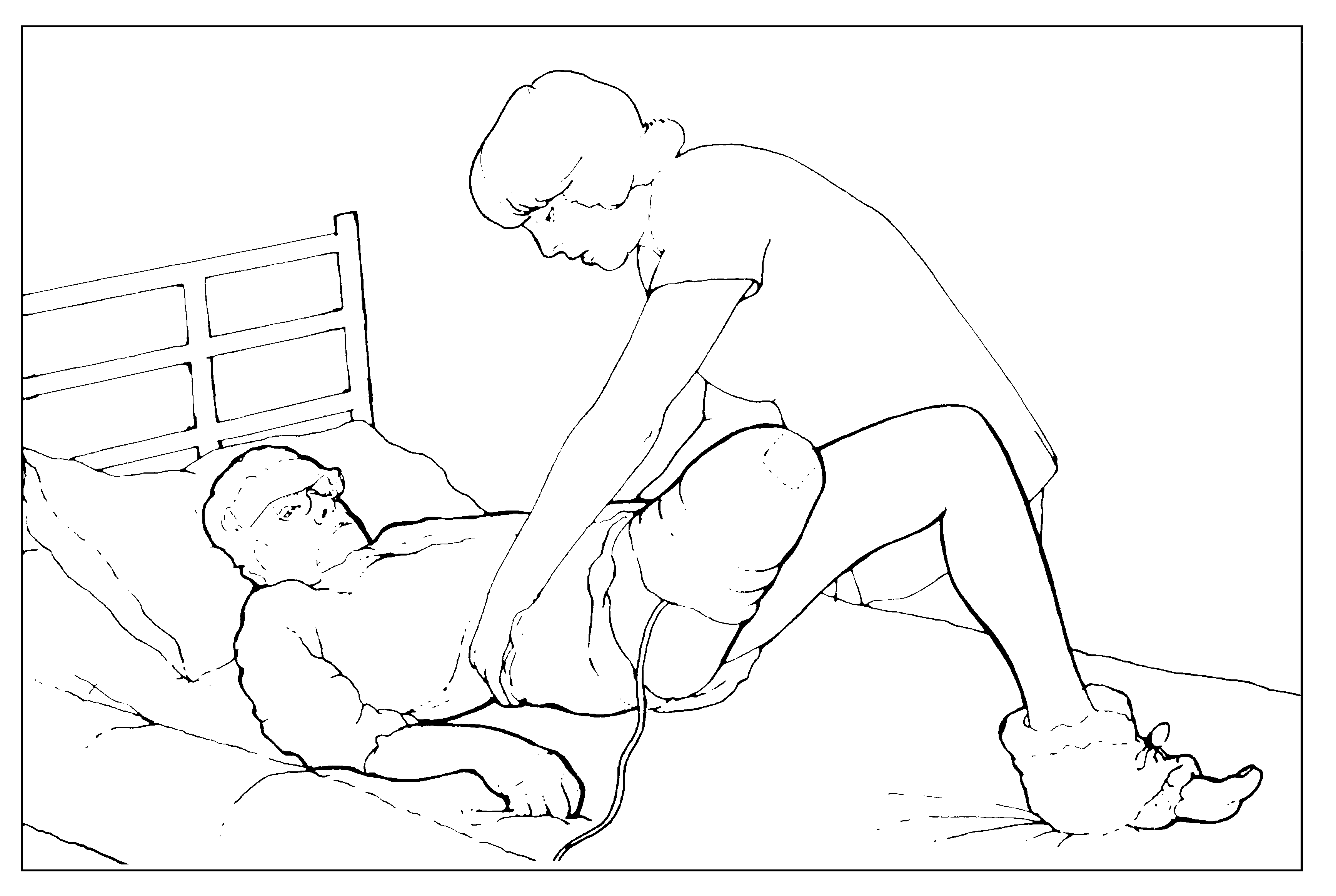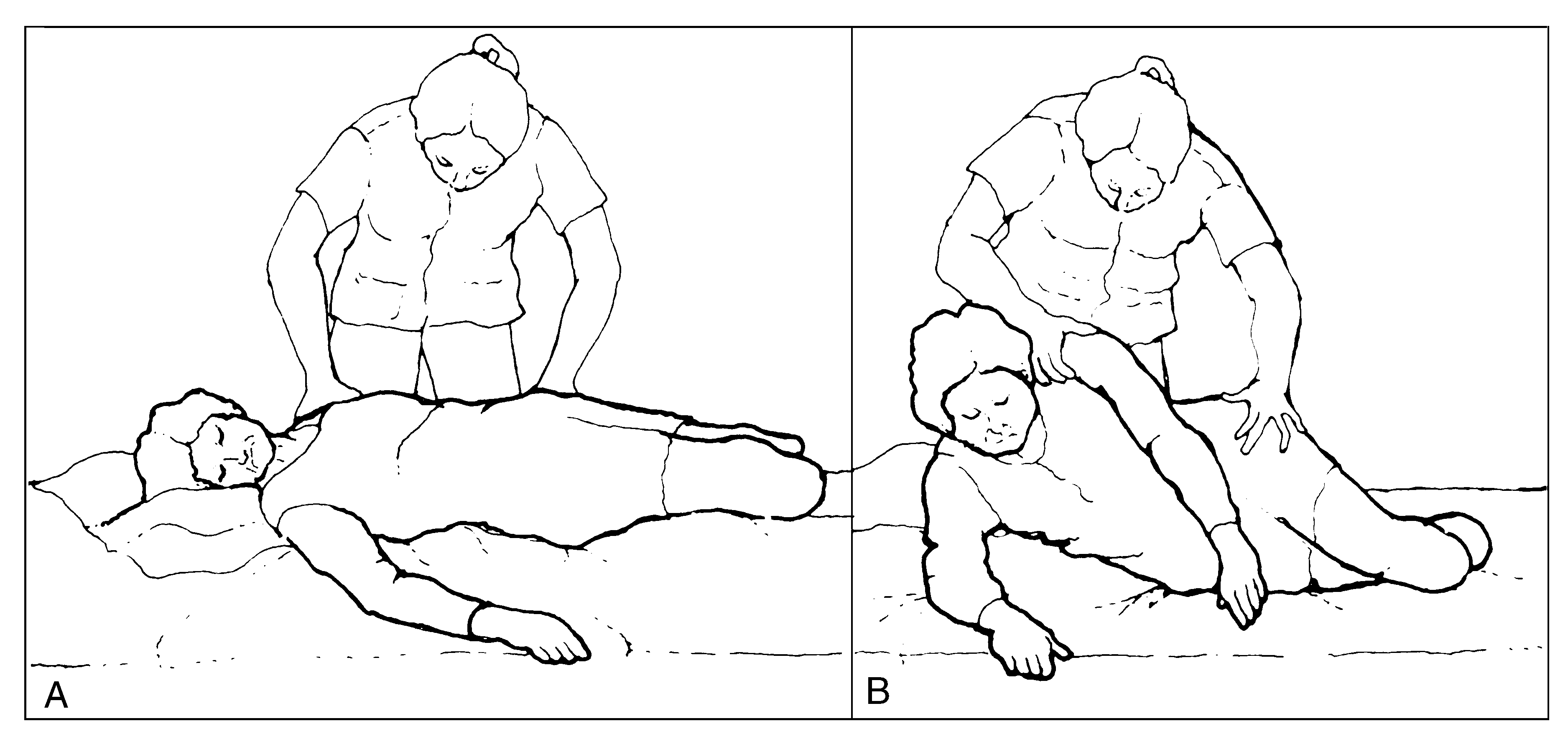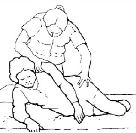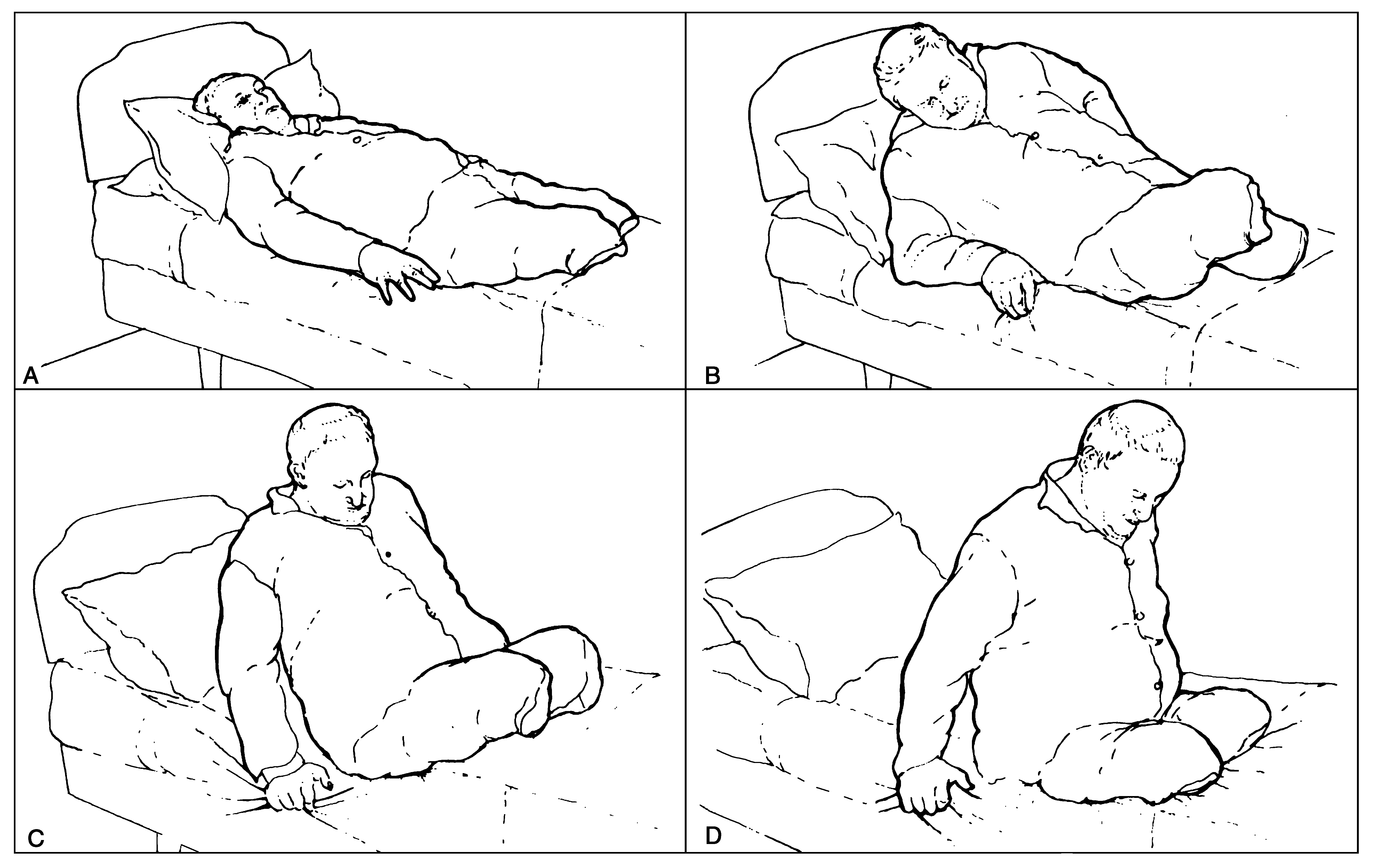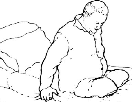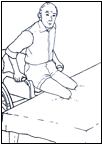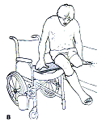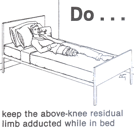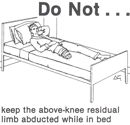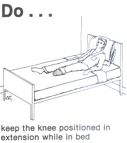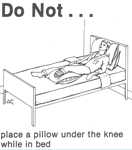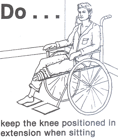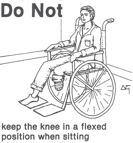Acute post-surgical management of the amputee: Difference between revisions
No edit summary |
No edit summary |
||
| Line 191: | Line 191: | ||
=== <br>Positioning === | === <br>Positioning === | ||
The main goal of a good positioning at any time is to prevent adjacent joint contractures. For trans-tibial amputee complete knee extension and flexion is needed and | The main goal of a good positioning at any time is to prevent adjacent joint contractures. | ||
* For trans-tibial amputee complete knee extension and flexion is needed and | |||
*For the trans-femoral amputee and knee desarticulation amputee - the full ROM of the hip, especially extension and adduction. | |||
'''Full ROM will ease prosthetic fitting and deambulation'''. <ref name="ICRC" /> | |||
Patient should be advised on how to position themselves while sitting and lying in the hospital bed or standing to prevent contractures. | Patient should be advised on how to position themselves while sitting and lying in the hospital bed or standing to prevent contractures. | ||
For | *For trans tibial : avoid as much as possible long position with a knee flexion (cushion under the knee for example) | ||
*For trans femoral : avoid position with hip flexion and abduction (cushion under the stump for example). | |||
For trans | |||
<br> | <br> | ||
| Line 221: | Line 225: | ||
<br> | <br> | ||
[[Image:TTdo2.png]] [[Image:TTdonot2.png]] | [[Image:TTdo2.png]] [[Image:TTdonot2.png]] | ||
== Resources == | == Resources == | ||
Revision as of 16:48, 8 June 2015
Original Editor - Liezel Wegner as part of the WCPT Network for Amputee Rehabilitation Project
Top Contributors - Admin, Tarina van der Stockt, Tony Lowe, Aicha Benyaich, Kim Jackson, Naomi O'Reilly, Sheik Abdul Khadir, Andeela Hafeez, Rucha Gadgil, Olajumoke Ogunleye and Jorge Rodríguez Palomino
Introduction[edit | edit source]
It is important to remember that earlier the onset of rehabilitation the greater the potential for success will be. The patient needs to recieve physiotherapy treatment early to avoid complications such as joint contractures, pathological scars and depressed psychological state. The main post-surgical complications are cardio-vascular, residual limb pain and phantom sensation, oedema, contracture and wound dehiscence. [1]
Goals of acute post-surgical rehabilitation [edit | edit source]
- Obtain maximum independence
- Prevent oedema
- Maintain joint ROM
- Prevent amyotrophy
- Decrease the muscular activation
- Prevent muscular weakness
- Prevent bronchopneumonia
- Prevent pressure sores
- Control pain
- Sensory reeducation
- Support the client psychologically
It is intented that prior to any treatment, an assessment will be carried out by the physiotherapist. In this early stage, a functional assessment can be done including both uper-limb, lower-limb and trunk in order to evaluate the patient potential to carry out activities such as transfer, wheelchair mobility and ambulation (with or without prosthesis)[1]
Treatment modalities[edit | edit source]
Treatment modalities to prevent complications include:
- Breathing exercises
- AROM
- Resistance exercises
- PROM
- Desensitising techniques
- Stump management
- Dressings
- Prevention of oedema
- Wound healing
- Pain
- Bed mobility and transfers
- Positioning
- ADL
- Walking and wheelchair use
Breathing exercises[edit | edit source]
Deep breathing exercises and relaxation exercises will help to increase vital capacity, decrease anxiety and prevent bronchopneumonia
Active range of motion (AROM)[edit | edit source]
Amputated side (from the 1st post op day unless the post surgical dressing restricts motion):
- First Hip flexion, ext, ADD, ABD
- Knee flexion exercises (for below-knee amptutations (BKA))
Amputated side (from the 3rd post op day)
- To reduce oedema BKA amputee should perform alternate knee flexion and extension.
- The knee disarticulation and TF amputee should perform alternate hip flexion and extension, hip ADD and ABD.
These active exercises must be performed at regular intervals during the day (10 repetitions per hour).
Bilateral activities often achieve a more vigorous contraction on the amputated side.
Resistance exercises[edit | edit source]
From the 1st post op day
- Isometric contraction of the quadriceps (BKA)
- Isometric contraction of gluteus, ADD and hip internal rotation
- Strengthening exercises of the sound lower limb (in progression)
From the 3rd post-op day
- Resistance exercises of the upper limbs
- Resistance exercises of the torso
PROM[edit | edit source]
Passive extension of a TT residual limb.[2]
The physiotherapist's hands should be positioned as proximal as possible to avoid any contact with the end of the stump, which is a very sensitive area.
Desensitising techniques
[edit | edit source]
Desensitization is believed to reduce pain in the residual limb and may help the patient with an amputation adjust to his or her new body image that now includes limb loss:
- Instruct the patient how to perform desensitization and distraction techniques to reduce the phantom pain
- Tap the residual limb, to include tapping the rigid dressing
- Gently massage the proximal residual limb, to include pressure points in the inguinal regions
- If the phantom toes or foot feel like they are twisted or cramping, move the intact limb in a position of comfort that would mimic the improved position of the phantom side.
Stump management
[edit | edit source]
The ideal stump is one that is well-healed, has good vascular supply, soft and mobile scars, minimal pain, minimal oedema, a length sufficient for biomechanical leverage but not too long to restrict choices for prosthetic components, and large surface areas for distribution of pressure. While the surgery plays a large part in creating the ideal stump, Physiotherapy is required to maximise chances of achieving this ideal.
One of the main acute post-operative factors affecting the time to prosthetic fitting and the speed of rehabilitation, is the wound healing of the stump, especially in the vulnerable vascular compromised population[3]. Oedema in the residual limb is also a common complications after LLA surgery[4]. Controlling the amount of oedema post-surgically is vital for promoting wound-healing, pain control, protecting the incision during rehabilitation and assisting in shaping the stump for prosthetic fitting[5]. Traditionally soft dressings or non-adhesive elastic bandages are used to prevent oedema of the stump post-surgically, but no evidence supports the use of these bandages[6][7]. The use of immediate post-surgical rigid or semi-rigid dressings to prevent acute oedema have increased in popularity in the developed world, and is well supported by evidence in the literature[5][6].
Post-operative dressing[edit | edit source]
Post operative dressing are used to protect the limb, reduce swelling, promote limb maturation and prevent contractures. There are two major classifications of post operative dressing that are commonly used:
- Soft dressings - descriptive studies indicate several disadvantages of soft dressings, such as high local or proximal pressure, tendency to loosen or fall off, limited mobilization, and extended hospital stays. Controlled studies found that the frequency of uncomplicated healing rates, postoperative pain, eventual use of a prosthesis, and mortality were not significantly different between soft and rigid types of dressings[8].
- Rigid dressings - rigid dressings have been used as best practice for post-operative stump management for many years. They come in 2 flavours: non removable thigh length casts, which protect the stump and maintain the knee in extension; and removable rigid dressings which enclose the stump to just below the knee, thus allowing the amputee to have knee flexion, and are easily removable to allow inspection of the stump. (for evidence of use see[8])
Some of the reported benefits of the rigid dressing include promotion of wound healing, shaping of the stump, pain management, protection against trauma during falls, stump volume control and increased speed of prosthetic fitting[5][6]. The conventional method of application of rigid dressings is a plaster cast rigid dressing that is usually applied in theatre under anaesthesia. This method has proven to be effective, but often surgeons choose not to opt for this method of rigid dressing since it is time-consuming, and requires some skill to apply[9].Another disadvantage of this technique is that the wound cannot be inspected for 5-7 days post surgically. An alternative vacuum-formed removable rigid dressing has proven to be as effective as the conventional rigid dressing in a randomized controlled trial, and is an useful alternative to the plaster casting method[3]. The advantages of this vacuum-formed rigid dressing include the ease of application, and ease of access for wound inspection[3].
Oedema control (shrinking)[edit | edit source]
In the BACPAR guidelines for oedema management in lower limb amputees[10] they conclude that based on the best current available evidence rigid/semi rigid dressings should be used when expertise, time and resources allow; the benefits are well documented in the literature. The PPAM aid, compression socks and stump boards have been shown to have some evidence base for oedema control and may be used in addition or in the absence of rigid dressings dependant on clinical judgement. However, these modalities are not necessarily primarily intended for use for oedema control. Their advantages include preparation for prosthetic rehabilitation, reduction in flexion deformities and maintenance/improvement in muscle tone and are important components of amputee rehabilitation. Compression socks and the PPAM aid are the only tools available for transfemoral amputees. Although compression socks are widely used as a form of oedema control there is very limited evidence on aspects such as timing of application, who should assess appropriateness and the frequency it should be worn for. It is suggested that further research is required in order to offer more clarity for clinicians in these areas.
| Video of Ossur semi-rigid dressing immediately post operatively | Iceross post op liner for compression post operatively |
Wound healing
[edit | edit source]
Wound healing is always a cause of concern, but especially in the dysvascular population. Adequately controlling oedema of the stump can assist with healing, but some evidence also supports the use of low intensity laser in order to facilitate and speed up wound healing in diabetic patients [3]. However the exact dosages for optimal effect has not yet been established.
Pain
[edit | edit source]
Pain is a very common physiological stressor that occurs during the acute postoperative period and affects the patient’s ability to learn new skills [5] . Adequately controlling the new amputee’s levels of pain greatly facilitates their early rehabilitation [5] . Physiotherapists should take this into consideration, and treat patients shortly after receiving their pain medication. Controlling oedema in the residual limb through positioning also assists in relieving acute postoperative pain [5]. Various physiotherapy interventions are used for the management of phantom limb pain, but very few of these have been studied to prove their efficacy in the research literature [11].One of the few physiotherapy modalities that has been proven to be effective for the management of residual phantom limb pain, is a 60 minute application of Transcutaneous Electrical Nerve Stimulation (TENS) [4].
For more information see the pain management of the amputee page.
Patient information
[edit | edit source]
A series of useful patient information guides from the Amputee Coalition.
- Perioperative_Pain_Management_Preview
- Avoiding_Secondary_Pain_Preview
- Living_with_Residual_Limb_Pain_Preview
- Living_with_Phantom_Limb_Pain_Preview_(1)
- Care_of_Your_Wounds_Preview
Bed mobility and transfers[edit | edit source]
Bed Mobility [12]
[edit | edit source]
- Bridging
- Rolling from one side to the other
- Sitting forward bilateral amputation
- Moving up and down on the bed.
- Push-ups using arms (after drain has been removed).
Transfers[edit | edit source]
- Standing pivot transfer (for a patient that can participate only partially)
- Backwards forwards transfer (for patient with a bilateral amputation)
- Lateral transfer with a sliding board transfer
Positioning[edit | edit source]
The main goal of a good positioning at any time is to prevent adjacent joint contractures.
- For trans-tibial amputee complete knee extension and flexion is needed and
- For the trans-femoral amputee and knee desarticulation amputee - the full ROM of the hip, especially extension and adduction.
Full ROM will ease prosthetic fitting and deambulation. [1]
Patient should be advised on how to position themselves while sitting and lying in the hospital bed or standing to prevent contractures.
- For trans tibial : avoid as much as possible long position with a knee flexion (cushion under the knee for example)
- For trans femoral : avoid position with hip flexion and abduction (cushion under the stump for example).
Bed positioning for trans-femoral [13]
Bed positioning for trans-tibial [13]
Sitting in a wheelchair for trans-tibial [13]
Resources[edit | edit source]
- Post-Operative Physiotherapy from AustPAR
References[edit | edit source]
References will automatically be added here, see adding references tutorial.
- ↑ 1.0 1.1 1.2 International Committee of the Red Cross (ICRC), ICRC physiotherapy reference manual: prothetic gait analysis, 2014
- ↑ Prosthetic gait analysis, a course manual for physiotherapists, ICRC, 2014
- ↑ 3.0 3.1 3.2 3.3 Johannesson A, Larsson G, Oberg,T Atroshi, I. Comparison of vacuum-formed removable rigid dressing with conventional rigid dressing after transtibial amputation. Acta Orthopeadica 2008;79(3); 361-369
- ↑ 4.0 4.1 Bryant G. Stump Care. The American Journal of Nursing 2001; 101(2); 67-71
- ↑ 5.0 5.1 5.2 5.3 5.4 5.5 Lusardi MM, Postoperative and preprosthetic care. In Lusardi, MM, Jorge, M and Nielsen, CC editors. Orthotics and Prosthetics in Rehabilitation, Third Edition. Missouri: Elsevier, 2013.p. 532-594.
- ↑ 6.0 6.1 6.2 Nawijn SE, Van der Linde H, Emmelot CH, Hofstad CJ. Stump management after transtibial amputation: a systematic review. Prosthetics and Orthotics International 2005; 29(1); 13-26.
- ↑ Smith DG, McFarland LV, Sangeorzan BJ, Reiber GE, Czerniecki JM. Postoperative dressing and management strategies for transtibial amputations: A critical review. Journal of Rehabilitation Research Development 2003; 40; 213-224.
- ↑ 8.0 8.1 Clinical Practice Guideline for Rehabilitation of Lower Limb Amputation (full version). Department of Veterans Affairs, Department of Defence, 2007, page 72-73
- ↑ Johannesson A, Larsson G, Ramstrand N, Lauge-Pedersen H, Wagner P, Atroshi I. Outcomes of a standardized surgical and rehabilitation program in trans-tibial amputation for peripheral vascular disease: A 10 year prospective cohort study. The American Journal of Physical Medicine and Rehabilitation / Association of Academic Physiatrists 2010; 89(4); 293-303.
- ↑ Elizabeth Bouch, Katie Burns, Elizabeth Geer, Matthew Fuller and Anna Rose. Guidance for the multi disciplinary team on the management of postoperative residuum oedema in lower limb amputees. BACPAR
- ↑ Mulvey MR, Radford HE, Fawkner HJ, Hirst L, Neumann V, Johnson MI. Transcutaneous electrical nerve stimulation for phantom pain and stump pain in adult amputees. Pain Practice. 2013; 13(4):289-96. fckLRdoi: 10.1111/j.1533-2500.2012.00593.x
- ↑ Barbara Engstrom and Catherine Van de Ven. Therapy for Amputees, 3rd Edition. 1999.
- ↑ 13.0 13.1 13.2 Bella J. May, AMPUTATIONS AND PROSTHETICS, F.A Davis Company, 2rd édition, 1996



